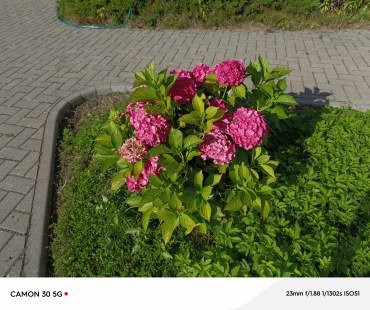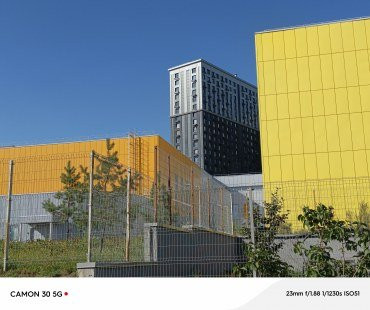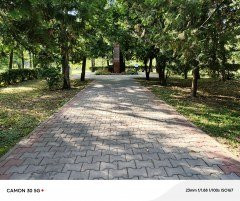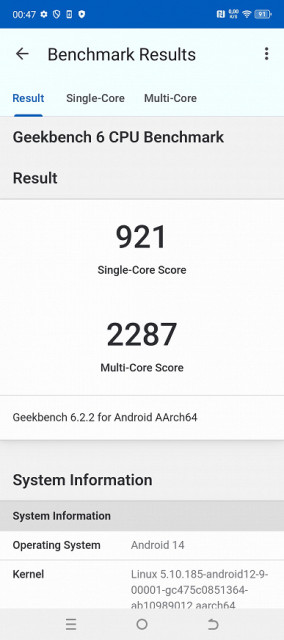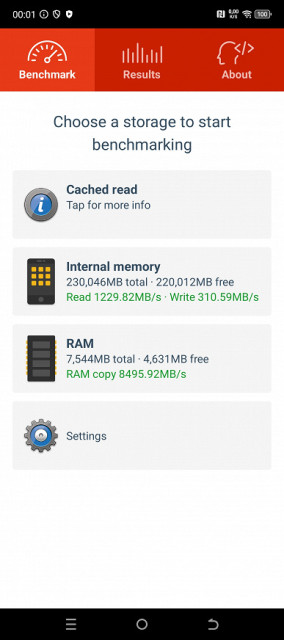Tecno has introduced a new model in the Camon 30 smartphone line — Tecno Camon 30 5G. Previously, the Camon 30 version was already on sale, but without support for 5G networks. The updated version adds not only 5G, but also other improvements, while the device remains affordable. The result is a balanced and inexpensive smartphone suitable for a wide audience. A special advantage was the version with a design from the famous brand Loewe, available for all models of the line. Today we will consider the smartphone in the Loewe Design Edition version.

Main characteristics of Tecno Camon 30 5G (model CL7)
- SoC Mediatek Dimensity 7020, 8 processor cores (2×Cortex-A78 @2.2 GHz + 6×Cortex-A55 @2.0 GHz)
- GPU IMG BXM-8-256
- OS Android 14, HiOS 14
- Touchscreen AMOLED, 6.78″, 1080×2436, 20:9, 393 ppi, 120 Hz
- RAM 8/12 GB, internal memory 256/512 GB
- No microSD support
- Nano-SIM support (2 pcs.)
- Networks 2G GSM, 3G WCDMA, 4G LTE, 5G
- GPS, GLONASS, BDS, Galileo
- Wi-Fi 6
- Bluetooth 5.3, A2DP
- NFC
- IR port
- USB 2.0 Type-C, USB OTG
- No 3.5 mm audio output for headphones
- Cameras 50 MP + 2 MP, video 2.5K@30 fps, 1080@60 fps
- Front camera 50 MP
- Proximity and light sensors, magnetic field, accelerometer, gyroscope
- Fingerprint scanner (under the screen)
- Battery 5000 mAh, charging 70 W
- Dimensions 165×76×7.8 mm
- Weight 199 g
Appearance and ease of use
The Tecno Camon 30 5G smartphone comes in a cardboard box decorated in the brand's signature colors.

The kit includes a 70W power supply, a connecting cable and a protective case.

The Tecno Camon 30 5G has a modern and stylish design. Instead of streamlined lines and narrow sides, the device has a flat front and back panel, as well as wide side edges. The smartphone fits comfortably in the hand, while its edges are not too sharp to cause discomfort.

An interesting color palette and a metallic element on the back panel give the device a stylish and attractive appearance. However, the overall design is marred by a large round platform with cameras, borrowed from other models of the brand. It looks rough and spoils the sophisticated look of the smartphone, although in fact there is only one camera installed here!
The designers tried to «refined» the round patch by adding a semblance of a watch bezel with small notches around it, but it would have been better if it had not been there at all. The side frame of the smartphone is made of matte painted plastic, and the back panel, according to the official description, can be made of glass or eco-leather.

The tested sample used eco-leather, which is pleasantly rough to the touch, does not slip and does not collect fingerprints. Time will tell how long this porous material will retain its appearance. In addition, there is a possibility that the coating on the side edges will begin to wear off over time from constant contact with hands. Why Chinese manufacturers chose to abandon the more durable metal remains unclear.

The smartphone is quite heavy, weighing almost 200 g. The included case is not flexible and transparent, but hard, made of rough matte colored plastic.

The side buttons are large, wide, with a short, elastic stroke. They are conveniently located on one side right under the fingers.

A single front camera lens is installed behind a round cutout in the screen matrix in the center of the top edge.

The fingerprint scanner is located under the bottom of the screen glass. The scanner is optical, works clearly, but not very quickly.

The pull-out tray can accommodate two Nano-SIM cards, but there is no support for microSD memory cards.

The bottom end contains a speaker, microphone and USB Type-C connector.

On the top end there is an additional microphone, IR emitter and a second speaker for stereo sound. However, the lack of a 3.5 mm audio jack is disappointing, even in the budget model, which violates all unspoken standards.

The Tecno Camon 30 5G is available in three colors — black, white and green. The Loewe Design Edition version that we tested is no different from the standard models in terms of functionality and price. The case is protected against water and dust according to the IP54 standard, providing only basic protection against splashes and rain.
Screen
Tecno Camon 30 5G features a 6.78-inch AMOLED display with a resolution of 1080×2436, which is covered with a flat protective glass. The physical dimensions of the screen are 70×158 mm, and the pixel density is 393 ppi. The width of the frames around the display is 3 mm on the sides and 4 mm at the top and bottom. The screen supports a refresh rate of 120 Hz.
The smartphone screen has a mirror-smooth glass surface that is resistant to scratches. In terms of anti-glare properties, the display is superior to the Google Nexus 7 (2013) screen. Its surface has an effective oleophobic coating, which is noticeably better than that of the Nexus 7, making fingerprints easier to remove and appearing slower than on regular glass.
With manual brightness adjustment and displaying a white field on the entire screen, the maximum brightness is about 540 cd / m² in normal conditions, and when activating the High Brightness Mode in bright light, it can reach 1000 cd / m². Thanks to excellent anti-glare properties, the display remains easy to read even in bright sunlight, and the dark theme helps save battery power and improve visibility in bright light. The minimum brightness is 4.5 cd / m², which allows you to comfortably use the device in complete darkness.
The smartphone is equipped with automatic brightness control using a light sensor, which is located on the front panel, next to the speaker grill. This function adjusts the screen brightness depending on external conditions. In complete darkness, auto-brightness reduces the level to 4.5 cd/m², in a lit office (approximately 550 lux) it increases to 130 cd/m², and in direct sunlight it increases to 1000 cd/m². However, the automatic adjustment system does not always accurately adjust to the individual user's preferences, returning to factory values after adjustment.
At high and medium brightness levels, modulation is observed at a frequency of 60, 90 or 120 Hz. Below are graphs of the dependence of brightness on time for various brightness settings in the mode with a refresh rate of 60 Hz.

At high and medium brightness, the modulation frequency is 60 Hz, but due to the low duty cycle and different modulation phases across the screen area, there is no visible flickering. With a significant decrease in brightness, the modulation frequency increases to 2.16 kHz, which also eliminates visible flickering.
In the screen settings, you can activate a mode with an increased refresh rate of up to 90 or 120 Hz.
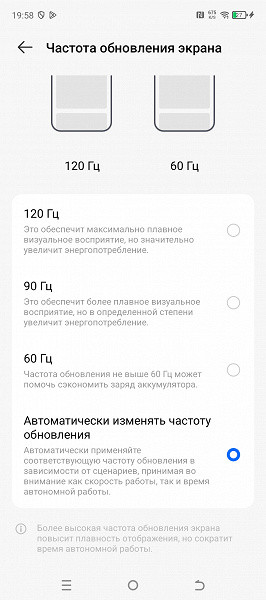
In 90 and 120 Hz modes, the smoothness of scrolling through the settings menu is noticeably improved. Let's see if the modulation pattern changes. 90 Hz refresh rate mode:

At high and medium brightness, the modulation frequency has increased to 90 Hz, while at low brightness it remains the same as at 60 Hz. There is still no visible flickering.
120 Hz mode:

The modulation frequency at high and medium brightness has now increased to 120 Hz, while at low brightness it remains the same as at a refresh rate of 60 Hz. There is still no visible flickering.
However, if you do not interact with the screen, the refresh rate drops to 60 Hz after a few seconds. High refresh rates (90 and 120 Hz) are activated only in some applications and in the system interface. For example, in Google Chrome, the refresh rate is always 60 Hz.
The display uses an AMOLED matrix — an active matrix on organic light-emitting diodes. A full-color image is formed using subpixels of three colors: red ®, green (G) and blue (B), while there are twice as few red and blue subpixels, which is designated as RGBG. This is confirmed by a fragment of a micrograph:
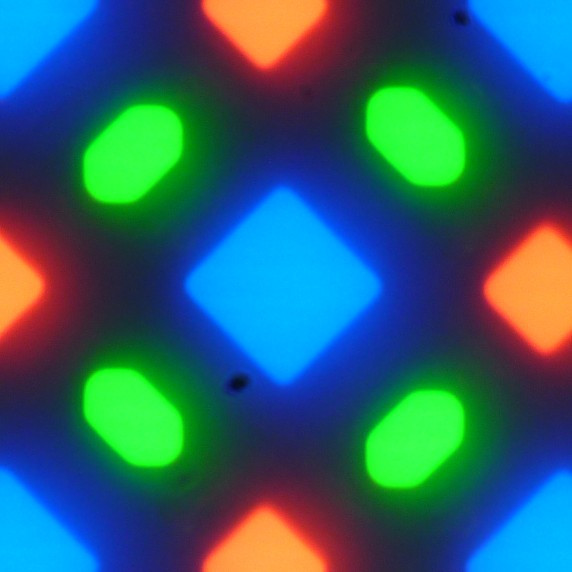
In the given fragment, you can see 4 green subpixels, 2 red (represented by 4 halves) and 2 blue (1 whole and 4 quarters). These elements can be repeated to cover the entire screen without gaps and overlaps. For such matrices, Samsung uses the name PenTile RGBG. At the same time, the manufacturer calculates the screen resolution based on green subpixels, which means that the resolution for red and blue will be lower. As a result, some unevenness at the borders of contrasts and other artifacts may be observed, but due to the high resolution, they minimally affect the overall image quality.
The screen also has excellent viewing angles. The brightness when viewed at an angle is noticeably reduced (compared to the Nexus 7), but this smartphone has a less pronounced drop in brightness. Therefore, even with the same formal brightness, the screen of this device looks much brighter than LCD screens, since it is often viewed at an angle. It is worth noting that at large deviations, the white color on the smartphone screen acquires a slight blue tint, while the black color remains deep and saturated at any viewing angle. Its blackness is so intense that the contrast parameter becomes inapplicable here. For clarity, we will provide photographs in which the smartphone and Nexus 7 screens display the same images. The brightness of both screens is initially set at about 200 cd / m², and the color balance on the camera is set to 6500 K.
The image shows a white field displayed perpendicular to the screens:

Note the good uniformity of brightness and color tone of the white field.
And the test image (Original color profile):

The colors on the smartphone screen look oversaturated (note the shades of tomatoes, bananas, napkins and faces), and the color balance is noticeably different. We remind you that the photo is not a reliable indicator of the quality of color rendering and is provided for illustration purposes only. For example, the pronounced reddish tint of white and gray in the photos of the smartphone screen is visually absent when viewed at a right angle, which is confirmed by hardware tests using a spectrophotometer. This is due to the fact that the spectral sensitivity of the camera matrix does not quite match the characteristics of human vision.
The photo above was taken with the «Original color» profile selected in the screen settings. There are two profiles available.

When choosing the first one, Vivid Colors, the colors are even more oversaturated and unnatural:

This effect is achieved by slightly expanding the color gamut and increasing the color contrast. Additionally, the hue can be adjusted (from «Cool color» to «Warm color»).
Switching the state of the matrix elements occurs almost instantly, but when turned on, a step of about 17 ms (which corresponds to a screen refresh rate of about 60 Hz), about 11 ms (90 Hz) or about 8 ms (120 Hz) can be observed. For example, this is how the brightness depends on time when switching from black to white:

In some conditions, such a step can cause (and does cause) the appearance of trails that follow moving objects.
The gamma curve, constructed using 32 points with equal intervals of gray shades, showed no dip in either shadows or highlights. The parameter of the approximating power function was 2.34, which is slightly higher than the standard value of 2.2. As a result, the image is slightly darkened, but the real gamma curve practically does not deviate from the power dependence.

Let us remind you that in OLED screens the brightness of image fragments changes dynamically depending on the nature of the displayed content — for light images the brightness decreases slightly. As a result, the obtained dependence of brightness on hue (gamma curve) may not fully correspond to the gamma curve of a static image, since the measurements were carried out with sequential output of gray shades almost on the entire screen.
The color gamut, even in the Original color mode, significantly exceeds sRGB and is close to the DCI-P3 space.
In the case of the Vivid Colors profile, the color gamut is slightly wider than DCI-P3:

In this case, the component spectra (that is, the spectra of pure red, green and blue colors) are very well separated:

In the case of the Original Color profile there is already some minor cross-mixing:

The grayscale balance looks acceptable after a small correction, since the color temperature is close to the standard 6500 K, and the deviation from the spectrum of an absolutely black body (ΔE) is less than 10 units, which is a good indicator for a consumer device. At the same time, the color temperature and ΔE remain stable from shade to shade, which has a positive effect on the visual perception of the color balance. (The darkest areas of the grayscale can be ignored, since the color balance there is not significant, and the measurement error of color characteristics at low brightness is large.)
Of course, there is a setting (Eye Protection Mode) that allows you to reduce the intensity of the blue component. Bright light can disrupt the daily (circadian) rhythm, but this can be solved by reducing the brightness to a comfortable level, rather than distorting the color balance by reducing blue.

This device probably does not support DisplayPort Alt Mode for USB Type-C, which means that outputting image and sound to external devices when connected to the USB port is not possible.
Let's sum it up. The screen demonstrates very high maximum brightness (up to 1000 cd/m²) and has excellent anti-glare properties, which allows you to use the device outdoors without problems even on a sunny day. In the dark, the brightness can be reduced to a comfortable level (up to 4.5 cd/m²). There is also an automatic brightness adjustment mode, which works quite adequately, but does not provide the user with the ability to customize it. The advantages of the screen include the absence of visible flickering, an effective oleophobic coating, and the ability to operate at a refresh rate of up to 90 or 120 Hz. In addition, it is worth noting the general advantages of OLED screens: true black color (without reflections), good uniformity of the white field, and a significantly smaller drop in brightness when viewed at an angle compared to LCD displays. However, it is worth mentioning the disadvantages, such as too wide a color gamut, which can lead to distortion and unnatural colors when viewing videos and photos. Overall, the screen quality is high.
Camera
The Tecno Camon 30 5G has only one rear camera, supported by an auxiliary 2-megapixel sensor.
This camera has a 50MP (1/1.57″) sensor and an f/1.9 lens, offering adequate phase-detection autofocus and optical stabilization. It shoots at 12.5MP by default, using 4-in-1 pixel binning, but also offers the ability to switch to other resolutions. However, when shooting larger images, they don’t quite measure up to the advertised 50MP, instead going up to 100MP thanks to what’s called a “high definition shooting algorithm.” Overall, the quality of the resulting images looks pretty good: noise is noticeable but not too distracting, detail is higher, and the image is sharp enough across the entire frame. However, this only applies to some photos (like the last pair in the gallery below); in other cases, the 100MP images are just crudely upscaled 12MP versions. We were unable to understand what affects the quality of the result, so we do not recommend relying on full-size photographs, since the gain in detail is not so significant.
In good lighting conditions, the camera demonstrates excellent results for an inexpensive smartphone. Although a small blur spot and slightly excessive sharpening are noticeable at the edge of the frame, overall there are no special complaints about the quality of the photos. Detail, clarity, contrast and volume are at a good level. The photos are obtained without overexposure and underexposed areas, distinguished by brightness and saturation — perhaps with slight distortions in colors.
Here are some more examples of photos taken with the main camera in auto mode:
Night shots have greatly reduced detail and artifacts from noise reduction, the colors are unnatural and unimpressive. They are only good as thumbnails.

Zoom is digital only, but thanks to the 50-megapixel sensor, 12-megapixel 2x zoom photos, which are a crop of the full-size image, look pretty good and provide a noticeable improvement in detail without degrading the image quality too much. This shooting mode seems like a better use of the large sensor to us than trying to create 100-megapixel photos.
The maximum digital zoom level is 10×.
The smartphone shoots video with a maximum resolution of 2.5K at 30 frames per second. The recording quality is good, with sufficient detail, richness and contrast, but there are slight overexposures and roughness in small parts. The low frame rate and lack of stabilization make shooting on the move difficult. In 1080p mode, it is possible to record 60 frames per second, but there is also no stabilization, which is activated only at 1080p@30 fps. However, even with it, the video sequence still looks a little jerky. Sound recording is done with average quality and noise.
The selfie camera effectively performs its functions: it does not distort color rendition, conveys a sufficient amount of detail and does not suffer from overexposure, although the overall brightness of the image remains high.
Telephone and communications
The Tecno Camon 30 5G smartphone has standard network capabilities: it supports the main ranges of 4G and 5G mobile networks, two Wi-Fi 6 ranges, Bluetooth 5.3 and NFC. However, there is no e-SIM support. In practice, within the city limits of Moscow, the device shows stable operation in wireless networks, does not lose connection and quickly restores the connection after a break. All the necessary sensors, including a gyroscope, are present.
The single-channel navigation module supports GPS, GLONASS, BDS and Galileo. The first satellites are found quickly, even with a cold start, and the positioning accuracy is high.
The volume of the speaker is sufficient, the voice of the interlocutor sounds clear. The vibration alert is of medium strength.
Software and multimedia
The Tecno Camon 30 5G smartphone uses Android 14 OS with the proprietary HiOS 14 shell. The interface works smoothly and quickly, the translation is correct, and the optimization does not cause any complaints. Many additional applications are pre-installed, but there are no pop-up ads. The notification shade is divided into two parts depending on the swipe angle. There is an official Google Play store, as well as full access to Google services.
The smartphone has stereo speakers, their sound is not as clear and detailed as that of more expensive models, but the volume is quite sufficient. Unfortunately, there is no audio output for a wired headset.
Performance
The Tecno Camon 30 5G smartphone is equipped with an eight-core SoC Mediatek Dimensity 7020, with a GPU IMG BXM-8-256. RAM is available in 8 or 12 GB options, and built-in storage is 256 or 512 GB. There is no option to install a memory card, but it supports connecting external devices via USB Type-C with USB OTG mode.
This platform was introduced on May 10, 2023 and is manufactured using a 6 nm process technology. It scores about 500 thousand points in AnTuTu, which corresponds to the average budget level. The performance is quite sufficient for everyday tasks and smooth operation of the interface, although more advanced video shooting modes are not available. You can play games, but at medium settings.
Testing in complex tests AnTuTu and GeekBench:
For convenience, we have collected all the smartphone test results in the current versions of popular benchmarks in tables. Several other devices from different price segments, tested on similar versions of benchmarks, have also been added to the tables, which allows you to better evaluate the obtained indicators. Unfortunately, it is impossible to include the results obtained on different versions of tests, so many worthy and relevant models that were previously tested on older versions of software remain «out of frame».
| Tecno Camon 30 5G (MediaTek Dimensity 7020) | Realme 12+ 5G (MediaTek Dimensity 7050) | Honor 200 Pro (Qualcomm Snapdragon 8s Gen3) | Honor 200 (Qualcomm Snapdragon 7 Gen3) | Google Pixel 8 Pro (Google Tensor G3) | |
|---|---|---|---|---|---|
| AnTuTu (v10.x) (higher is better) | 479937 | 620852 | 1297546 | 792657 | 1033512 |
| GeekBench 6 (bigger is better) | 921/2287 | 929/2277 | 1740/4535 | 1159/3206 | 1566/3701 |
Testing the graphics subsystem in GFXBenchmark gaming tests:
| Tecno Camon 30 5G (MediaTek Dimensity 7020) | Realme 12+ 5G (MediaTek Dimensity 7050) | Honor 200 Pro (Qualcomm Snapdragon 8s Gen3) | Honor 200 (Qualcomm Snapdragon 7 Gen3) | Google Pixel 8 Pro (Google Tensor G3) | |
|---|---|---|---|---|---|
| GFXBenchmark Aztec Ruins OpenGL (Onscreen, fps) | 20 | 29 | 45 | 56 | 107 |
| GFXBenchmark Aztec Ruins Vulkan (Onscreen, fps) | 19 | 26 | 129 | 66 | 108 |
| GFXBenchmark Car Chase ES 3.1 (1080p Offscreen, fps) | 19 | 26 | 96 | 47 | 78 |
| GFXBenchmark Manhattan ES 3.1 (1080p Offscreen, fps) | 35 | 45 | 169 | 83 | 142 |
| GFXBenchmark T-Rex (1080p Offscreen, fps) | 73 | 105 | 434 | 174 | 328 |
Testing in browser cross-platform tests:
| Tecno Camon 30 5G (MediaTek Dimensity 7020) | Realme 12+ 5G (MediaTek Dimensity 7050) | Honor 200 Pro (Qualcomm Snapdragon 8s Gen3) | Honor 200 (Qualcomm Snapdragon 7 Gen3) | Google Pixel 8 Pro (Google Tensor G3) | |
|---|---|---|---|---|---|
| Google Octane 2 (bigger is better) | 30667 | 7230 | 19467 | 24106 | 52617 |
| JetStream (bigger is better) | 97 | 29 | 70 | 60 | 102 |
Memory speed test results:
Heat
We test for performance degradation when heating using the Burnout Benchmark program, which allows you to load the CPU, GPU and NPU:
| Load on | Heating performance, as a percentage of maximum |
|---|---|
| CPU | 56% |
| GPU | 94% |
| NPU | 31% |
Battery life
The Tecno Camon 30 5G smartphone is equipped with a standard 5000 mAh battery and demonstrates good autonomy in tests. Testing was carried out without activating power saving functions, although they are provided in the device. Test conditions: the screen was set to the minimum comfortable brightness level (about 100 cd / m²). Three tests were carried out: continuous reading in the Moon + Reader application (using a light theme), continuous viewing of HD video (720p), and the Injustice 2 game with automatic graphics settings.
| Battery capacity | Reading mode | Video mode | 3D gaming mode | |
|---|---|---|---|---|
| Tecno Camon 30 5G | 5000 mAh | 22 h. 00 m. | 20 h. 00 m. | 7 h. 00 m. |
| Realme 12+ 5G | 5000 mAh | 24 h. 00 m. | 25 h. 00 m. | 7 h. 00 m. |
| Oppo Reno11F 5G | 5000 mAh | 22 h. 00 m. | 19 h. 00 m. | 7 h. 00 m. |
| Infinix GT 20 Pro | 5000 mAh | 19 h. 00 m. | 16 h. 00 m. | 6 h. 30 m. |
| Tecno Pova 6 Pro 5G | 6000 mAh | 22 h. 00 m. | 20 h. 00 m. | 7 h. 00 m. |
| Infinix Note 40 Pro | 5000 mAh | 18 h. 00 m. | 15 h. 00 m. | 6 h. 00 m. |
| Tecno Spark 20 Pro+ | 5000 mAh | 18 h. 00 m. | 14 h. 00 m. | 6 h. 00 m. |
| Vivo V30 | 5000 mAh | 23 h. 00 m. | 21 h. 00 m. | 8 h. 00 m. |
All these results were obtained under ideal conditions, including no SIM cards installed. Any changes in usage will likely worsen the battery life.
The smartphone was fully charged from the included charger in 1 hour. Wireless charging is not supported.
Conclusion
Tecno Camon 30 5G is a decent budget smartphone, without any striking features, but also without significant drawbacks. It combines a high-quality AMOLED screen and a modern, although not the most powerful, MediaTek platform. The camera copes well with photos for its price, but video shooting is not impressive. Autonomy is at a good level, the design is stylish and modern, but there is no mini-jack and support for memory cards. The cost of the model with 8/256 GB of memory has already dropped to $ 235, which makes it a good option for this money.














